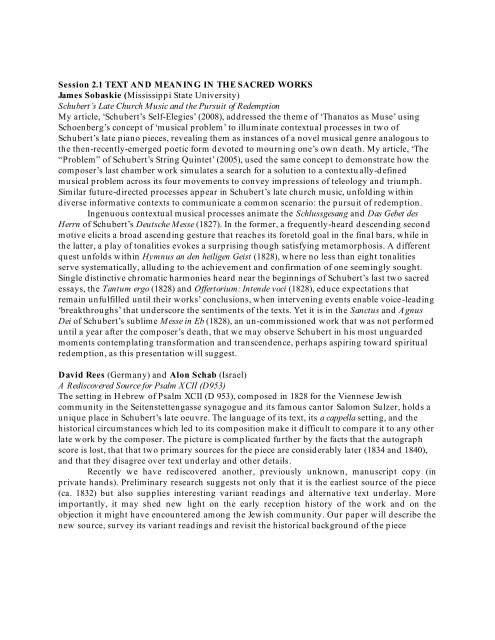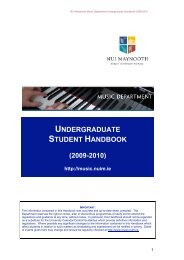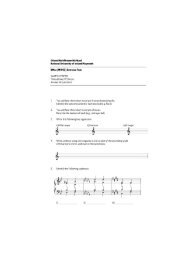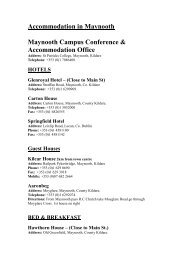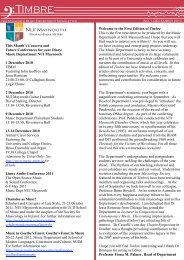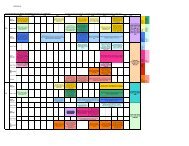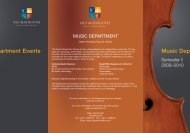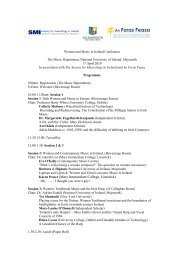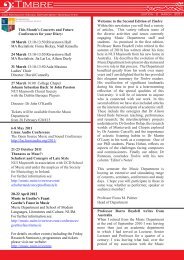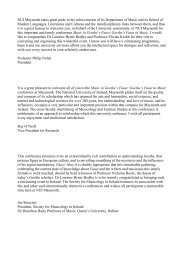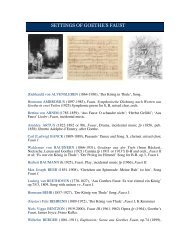Conference Booklet - Music - National University of Ireland, Maynooth
Conference Booklet - Music - National University of Ireland, Maynooth
Conference Booklet - Music - National University of Ireland, Maynooth
You also want an ePaper? Increase the reach of your titles
YUMPU automatically turns print PDFs into web optimized ePapers that Google loves.
Session 2.1 TEXT AND MEANING IN THE SACRED WORKS<br />
James Sobaskie (Mississippi State <strong>University</strong>)<br />
Schubert’s Late Church <strong>Music</strong> and the Pursuit <strong>of</strong> Redemption<br />
My article, ‗Schubert‘s Self-Elegies‘ (2008), addressed the theme <strong>of</strong> ‗Thanatos as Muse‘ using<br />
Schoenberg‘s concept <strong>of</strong> ‗musical problem‘ to illuminate contextual processes in two <strong>of</strong><br />
Schubert‘s late piano pieces, revealing them as instances <strong>of</strong> a novel musical genre analogous to<br />
the then-recently-emerged poetic form devoted to mourning one‘s own death. My article, ‗The<br />
―Problem‖ <strong>of</strong> Schubert‘s String Quintet‘ (2005), used the same concept to demonstrate how the<br />
composer‘s last chamber work simulates a search for a solution to a contextu ally-defined<br />
musical problem across its four movements to convey impressions <strong>of</strong> teleology and triumph.<br />
Similar future-directed processes appear in Schubert‘s late church music, unfolding within<br />
diverse informative contexts to communicate a common scenario: the pursuit <strong>of</strong> redemption.<br />
Ingenuous contextual musical processes animate the Schlussgesang and Das Gebet des<br />
Herrn <strong>of</strong> Schubert‘s Deutsche Messe (1827). In the former, a frequently-heard descending second<br />
motive elicits a broad ascending gesture that reaches its foretold goal in the final bars, while in<br />
the latter, a play <strong>of</strong> tonalities evokes a surprising though satisfying metamorphosis. A different<br />
quest unfolds within Hymnus an den heiligen Geist (1828), where no less than eight tonalities<br />
serve systematically, alluding to the achievement and confirmation <strong>of</strong> one seemingly sought.<br />
Single distinctive chromatic harmonies heard near the beginnings <strong>of</strong> Schubert‘s last two sacred<br />
essays, the Tantum ergo (1828) and Offertorium: Intende voci (1828), educe expectations that<br />
remain unfulfilled until their works‘ conclusions, when intervening events enable voice-leading<br />
‗breakthroughs‘ that underscore the sentiments <strong>of</strong> the texts. Yet it is in the Sanctus and Agnus<br />
Dei <strong>of</strong> Schubert‘s sublime Messe in Eb (1828), an un-commissioned work that was not performed<br />
until a year after the composer‘s death, that we may observe Schubert in his most unguarded<br />
moments contemplating transformation and transcendence, perhaps aspiring toward spiritual<br />
redemption, as this presentation will suggest.<br />
David Rees (Germany) and Alon Schab (Israel)<br />
A Rediscovered Source for Psalm XCII (D953)<br />
The setting in Hebrew <strong>of</strong> Psalm XCII (D 953), composed in 1828 for the Viennese Jewish<br />
community in the Seitenstettengasse synagogue and its famous cantor Salomon Sulzer, holds a<br />
unique place in Schubert‘s late oeuvre. The language <strong>of</strong> its text, its a cappella setting, and the<br />
historical circumstances which led to its composition make it difficult to compare it to any other<br />
late work by the composer. The picture is complicated further by the facts that the autograph<br />
score is lost, that that two primary sources for the piece are considerably later (1834 and 1840),<br />
and that they disagree over text underlay and other details<br />
Recently we have rediscovered another, previously unknown, manuscript copy (in<br />
private hands). Preliminary research suggests not only that it is the earliest source <strong>of</strong> the piece<br />
(ca. 1832) but also supplies interesting variant readings and alternative text underlay. More<br />
importantly, it may shed new light on the early reception history <strong>of</strong> the work and on the<br />
objection it might have encountered among the Jewish community. Our paper will describe the<br />
new source, survey its variant readings and revisit the historical background <strong>of</strong> the piece


